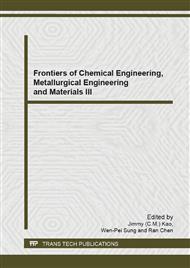p.526
p.530
p.534
p.538
p.542
p.546
p.550
p.554
p.560
Effects of Rotation Speeds and Media Density on Ground Calcium Carbonate during Ultrafine Grinding Process in Planetary Mill
Abstract:
Superfine ground calcium carbonate (GCC) produced by carbonate minerals is a widely used inorganic powder material. In order to get a finer GCC powder with narrow distribution span, the effect of rotational speed and media density on ground GCC were studied by dry grinding GCC in a planetary ball mill under different rotational speed and various media density. The grinding limit-particle size and distribution of grinding calcium carbonate were measured by centrifugal sedimentation granulometer. The structure of GCC was measured by X-ray diffraction. The result shows that low rotational speed and high-density media is conducive to get a product with smaller particle size and narrow size distribution; crystal plane (012) and (122) are more stable than (018) and (116).
Info:
Periodical:
Pages:
542-545
Citation:
Online since:
August 2014
Authors:
Price:
Сopyright:
© 2014 Trans Tech Publications Ltd. All Rights Reserved
Share:
Citation:


